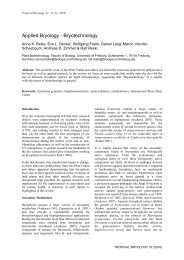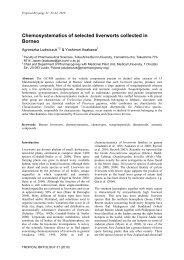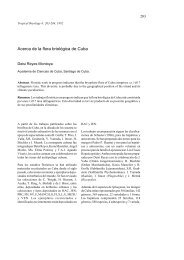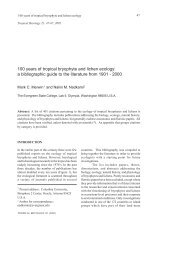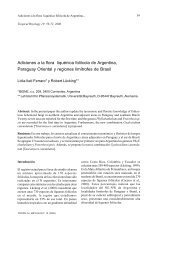Full text pdf - Tropical Bryology
Full text pdf - Tropical Bryology
Full text pdf - Tropical Bryology
Create successful ePaper yourself
Turn your PDF publications into a flip-book with our unique Google optimized e-Paper software.
66<br />
Type: (China, Prov. Yünnan), in<br />
Bambusbestanden der tp. St. im birm. Mons.<br />
unter dem Doker-la an der tibetischen Grenze,<br />
28° 15’, Granitboden, 3600 m., non-fruiting,<br />
18.IX.1915, Handel-Mazzetti no. 8174, H!, holo.<br />
In cross sections the stem is not fluted, there is<br />
no central strand present. No gemmae were<br />
found. Whitish tomentum along the stem is<br />
present. The lamina papillae are bifid (forked).<br />
These characters and some others, lead me to the<br />
conclusion that this taxon is Leptodontium<br />
viticulosoides. The latter taxon is rather variable<br />
(Zander 1972: 248; Zander 1993: 132).<br />
Although Fleischer (1902: 367) illustrates<br />
“Brutknollen” for Leptodontium viticulosoides<br />
(as L. subdenticulatum), I have never found them;<br />
compare also Zander (1972: 248). The last author<br />
treats this section of Leptodontium as, among<br />
other things, lacking simple propagulae (Zander<br />
1972: 243).<br />
Leptodontium flexifolium (With.) Hampe in<br />
Lindb., Oefv. K. Vet. Ak. Foerh. 21:227, 1864.<br />
Bryoerythrophyllum yichunense C.H. Gao, Fl.<br />
Musc. Chinae Bor.-Oc. 379 + fig. 80, 1977 syn.<br />
nov. Type: (China), Prov. Heilungkiang, Xiaochingan-ling<br />
Yichun, in truncis arborum<br />
silvaticarum (Betula dahurica Pall.), alt. 750 m.,<br />
non-fruiting, with gemmae, 4 Aug. 1957, P.C.<br />
Chen and C.H. Gao no. 346, hb. IFSBH!; L!, iso.<br />
Recently, it was possible to study the original<br />
material of Bryoerythrophyllum yichunense C.H.<br />
Gao. The general tinge of the plants is pale<br />
yellowish. Simple axillary gemmae are present.<br />
Sections through the stem show no central strand;<br />
the leaf margins are irregular dentate in the upper<br />
half and slightly recurved below. The leaf stance<br />
when wet is erect-spreading. The leaf base is<br />
simple, hyaline, without colouring. The lamina<br />
cells are pluri-papillose. Sections through the<br />
costa point to the genus Leptodontium (C. Muell.)<br />
Hampe and not to the genus Bryoerythrophyllum<br />
P.C. Chen, nor Zygodon Hook. & Tayl. All other<br />
characters lead me to the conclusion that the type<br />
belongs to Leptodontium flexifolium.<br />
Note on Leptodontium handelii Thér.<br />
Sollman<br />
Although Gao (1996: 258) and Zander (1993:<br />
310) treat this taxon as distinct, Redfearn et al.<br />
(1996: 248) reduced this name to Leptodontium<br />
flexifolium (With.) Hampe.<br />
However, Thériot (1932: 171) replaced<br />
Leptodontium subfilescens Broth., which is a<br />
hom. illeg., and gave the new name Leptodontium<br />
handelii Thér.<br />
Zander (1972: 231) treated Leptodontium<br />
subfilescens Broth. as identical with<br />
Leptodontium flexifolium (With.) Hampe, not<br />
citing Leptodontium handelii Thér.<br />
Judging only from the figure in Chen (1941: 316,<br />
Abb. 79: 4-8), which is not the lectotype selected<br />
by Zander (1972: 231), the reduction by Redfearn<br />
et al. (1996: 248) is quite correct.<br />
Acknowledgements<br />
I wish to thank Dr. C.H. Gao (Shenyang, China) for<br />
making available for my study the original material of<br />
Bryoerythrophyllum yichunense.<br />
References<br />
Chen, P.C. 1941. Studien über die ostasiatischen Arten<br />
der Pottiaceae I und II. Hedwigia 80: 1-76; 141-322.<br />
Chuang, C.C. 1973. A moss flora of Taiwan exclusive<br />
of essentially pleurocarpous families. J. Hattori Bot.<br />
Lab. 37: 419-509.<br />
Eddy, A. 1990. A handbook of Malesian Mosses, vol.<br />
2. London.<br />
Fleischer, M. 1902. Die Musci der Flora von<br />
Buitenzorg 1: 1-379. Leiden.<br />
Gao, C. (editor in chief), X.J. Li, Z.H. Li, P.J. Lin<br />
& T. Cao, 1996. Flora Bryophytorum Sinicorum, vol.<br />
2. Beijing (<strong>text</strong> in Chinese; with figures).<br />
Norris, D.H. & Koponen, T. 1989. Bryophyte flora<br />
of the Huon Peninsula, Papua New Guinea, XXVIII.<br />
Acta Bot. Fennica 137: 81-138.<br />
Redfearn, P.L., jr., B.C. Tan & Si He, 1996. A newly<br />
updated and annotated checklist of Chinese Mosses.<br />
J. Hattori Bot. Lab. 79: 163-357.<br />
Thériot, I. 1932. Mousses de la Chine orientale. Ann.<br />
Crypt. Exot. 5: 167-189.<br />
Wijk, R. van der, W.D. Margadant, & P.A.<br />
Florschütz, 1959-1969. Index Muscorum. Utrecht.<br />
Zander, R.H. 1972. Revision of the genus<br />
Leptodontium (Musci) in the New World. Bryologist<br />
75: 213-280.<br />
Zander, R.H. 1993. Genera of the Pottiaceae: Mosses<br />
of harsh environments. New York.<br />
TROPICAL BRYOLOGY 21 (2002)



